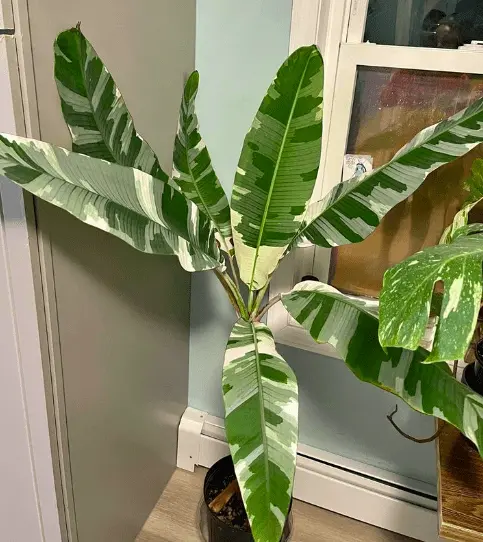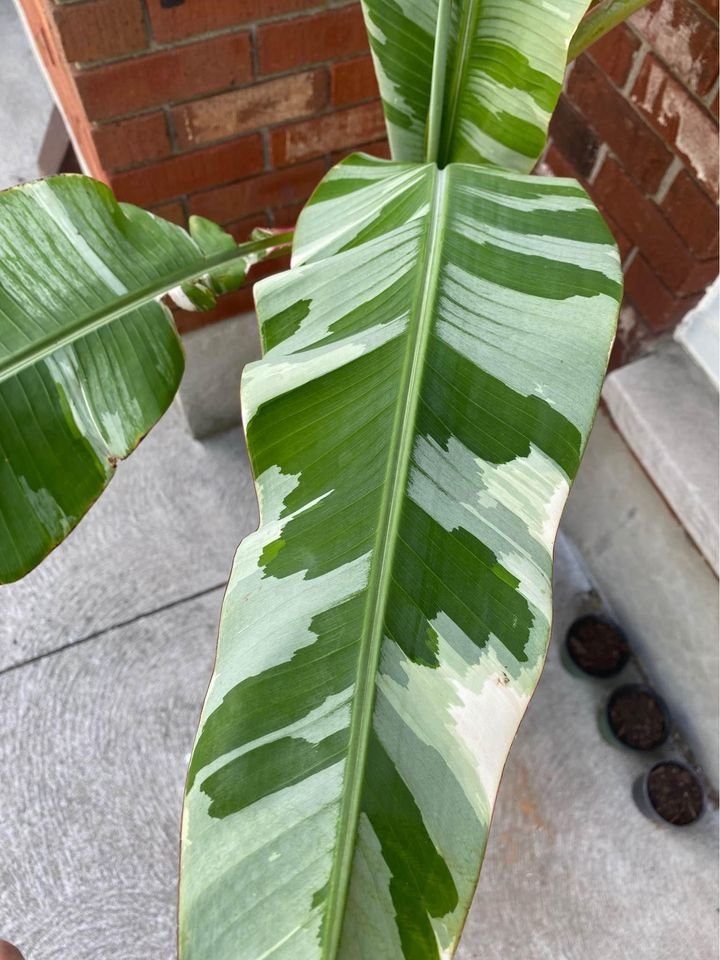Growing and caring for a variegated banana plant is easy if you know what you’re doing. However, it can also be one of the more challenging plants to take care of if you don’t know how they should be cared for. With its unique leaves, this striking plant looks beautiful against white and light-colored walls, and its slender leaves add an exotic flair to any indoor or outdoor space.
Variegated banana plants are among the most popular houseplants due to their long-lasting and easy-to-care-for nature. However, there’s still some doubt about what type of variegation will appear on the leaves, so it’s essential to learn how to grow and care for your plant if you’re hoping to get the pattern you want.
This guide will cover all the essentials for growing and caring for variegated bananas.
What is a Variegated Banana Plant?

Variegated bananas are a tropical, perennial plant widely present in the Hawaiian Islands. This unique plant is characterized by its vast green, white, and striped leaves, which give this species its name. The leaves sprout from a rhizome of densely packed leaf sheaths ready to burst.
Variegated banana plants are beautiful additions to any home or office. They can be grown indoors as well, but they prefer the outdoors. They love the sun, so ensure you plant them where they’ll get plenty of sunshine, preferably six hours per day.
They also need shade during the hottest parts of the day, so ensure they are protected from direct sunlight. Variegated bananas like moist soil but are not soggy, so if it gets too wet, they will rot faster than other varieties of bananas.
Types of Variegated Banana Plants
The banana plant comprises different hybrids and species that you can grow. Some of the most common names are:
Dwarf Cavendish banana

Also known as ‘Dwarf Musa Banana.’ The term dwarf relates to their height, reaching nearly 6 feet if adequately nourished. They develop quickly and are simpler to handle. These characteristics make it an excellent choice for indoor cultivation.
Musa Florida
They have white-green variegated leaves and are related to Aeae. There are so many similarities that it might be difficult to differentiate which one is which!
Musa Aeae

These plants are well-known for their lush green and white color scheme. They are a beautiful plant to grow anyplace, with a height of 14-16 feet and mint, white, and light green striping on the leaves.
Dwarf Nam Wah
These trees can grow up to ten feet tall and develop rapidly. The color variations include yellow and green, ideal for creating a tropical atmosphere in your home.
Growing a Variegated Banana Plant
The key to having a healthy and thriving variegated banana plant lies in understanding its growth needs and how to care for it properly throughout the year, beginning when you get your new plant home and continuing until it becomes large and mature.
Here are some essential tips on growing a variegated banana plant in your home or business. Before we get started on planting a banana tree, let’s go through everything you’ll need:
- A new banana tree (stem)
- Compost
- Soil for planting
- Pruning shears or a pruning knife
- Mulch
- Shovel
- Water availability
- Fertilizer 10-10-10
Step 1: Dig a hole.
Your hole should be roughly 1.5 feet deep and 1.5 feet broad. This may appear to be a lot for a little banana plant, but it will help the roots to expand freely in the first year. You can also use a shovel to soften the bottom and sidewalls of the hole to help grow the roots. This is especially useful if your soil is thick and compacted.
Step 2: Get a young banana tree (stem)
Extract the banana tree from its container. You’ll need to tear up the roots before putting the banana tree in the hole. When nursery plants have outgrown their containers and are set to be planted, they frequently get rootbound. The roots will tangle together and create a ball. Breaking up the roots before planting a banana tree encourages them to spread out in the soil, increasing the growth of the banana plant.
Step 3: Prepare the planting soil
Instead of using the original dirt to fill the hole, you will create nutrient-rich soil to enclose the banana plant. Insert the banana plant in the hole’s center. If you don’t have anybody to hold it while you fill the gap, you can temporarily attach a stake to it.
Step 4: Pour in the organic compost
Begin with a layer of gardening or planting soil. This is different from potting soil because it is designed to blend with soil already existing in your garden. Hence, ensure to layer on composted manure or other natural compost after that.
Step 5: Mix in the fertilizer
After you’ve added the compost, apply a layer of fertilizer before covering the hole entirely. To do this, use an NPK ratio of 10-10-10, ideal for propagating banana plants before filling the rest of the hole with compost and garden soil. This will result in rich soil nourishing the plant and draining it effectively. Use your foot to expel any air pockets that may have formed around the roots.
Step 6: Cover with mulch
After filling the hole, apply a one-inch layer of mulch over the soil to form a barrier that will keep the soil wet. Mature banana trees may tolerate some drying out, but the more water your tree receives, the better it will grow and produce fruit.
Leave a few inches exposed at the tree’s base before mulching it to allow it to breathe. However, piling mulch against the tree can increase the likelihood of the tree decaying or contracting a disease.
Step 7: Water the plant
The final step in planting variegated banana plants is properly water the banana tree. Watering it every day for the first year is a fantastic strategy. After the banana tree has been established for at least a year, water it every 2-3 days or when the upper part of the soil dries off.
Caring for Your Variegated Banana Plant
Whether grown in containers or on the ground, variegated banana plants are attractive ornamental plants. They are relatively easy to grow, but like all plants, they need some care. Some important things to remember when caring for your variegated banana plant are as follows:
1. Pruning Your Banana Plant
The first thing you should know about caring for your variegated banana plant is how to prune it. Pruning helps maintain the plant’s shape, but it also reduces water usage because it reduces the number of leaves exposed to sunlight. Ensure to leave any stubs behind when trimming back older branches, as this will lead to rot and disease.
To correctly prune your variegated banana plant, cut off branches crossing one another or preventing other branches from getting sunlight. You will also want to ensure space between branches so the growth can spread evenly.
2. Choosing the Right Location
Variegated banana plants grow best in bright, indirect light and can tolerate partial shade but are more likely to develop sunburned leaf tips. Keeping your plant near a window where it will get some airflow is recommended if you live in an area with high humidity. If you have other plants nearby, make sure their leaves don’t block the sunlight your banana tree needs.
3. Watering and Fertilizing
You should water your banana plant every two weeks, but wait until you have dried out the top inch of soil before doing so. Fertilize with an all-purpose fertilizer twice a year, in late winter and summer. If you want more blooms, fertilize monthly using an organic fertilizer that does not contain nitrogen.
4. Temperature
Caring for your variegated banana plant is easy, but some things can make it difficult. You should never overwater the soil in your pot, or it will rot. Before watering again, be patient and let the soil dry out. The other thing you need to be careful with is temperature.
The variegated banana plant has very precise heat requirements. It needs a lot of light but can only get up to 90 degrees Fahrenheit. If the temperature gets too high, move it away from the windows or turn on an air conditioner. If this doesn’t work, cut off all leaves on one side of the stem to reduce its heat exposure.
5. Light
Although some types like full sun and others prefer partial sun, variegated banana plants enjoy lots of light. Full sun may sometimes burn and harm the plant. However, they must be exposed to sunshine for at least eight hours daily, and indirect sunlight is preferable for safety. You may leave them outside during the summer or just set them near a wide south-facing window to guarantee adequate sunshine.
Variegated bananas are not as demanding as other plants in terms of care so they can be left out on the porch or deck during summer months. But, if you don’t have these outdoor areas, keeping your variegated banana plant inside and near a window with plenty of sunlight is best. If you do this, you will soon enjoy an abundant harvest from your variegated banana plant!
